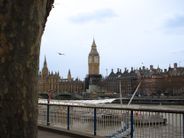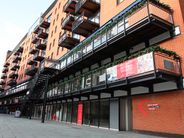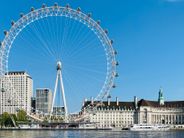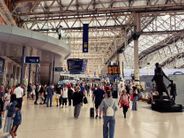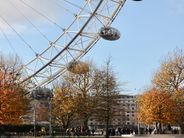
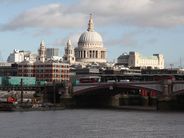
Waterloo
Average sold price last 12 months
£645,565
What it's all about?
As its name hints, much of the Waterloo area was marshy up until the 1700s before the region began to be drained to make way for industry. The opening of Waterloo station in 1848 had a major effect as it expanded to become the busiest station in London, as did rebuilding work nearly a century later for the Festival of Britain in 1951. Falling outside the jurisdiction of the City and not subject to the same laws, the riverside areas now known as the South Bank and Bankside has been an entertainment centre since the Middle Ages, attracting revellers to its theatres, pleasure gardens and street performances. Today, the tradition continues with the Southbank centre offering a wide-ranging arts and events programme that brings in visitors from all over the world. As well as having a thriving arts scene on their doorstep, residents have their pick of restaurants, bars, pubs and markets – all of which add up to make this a lively urban hub in which to live.
Fact file
- When Waterloo was unveiled as the original London terminus of the Eurostar, a prominent Parisian politician requested its name be changed for fear it would remind the French of their defeat at the Battle of Waterloo – an appeal that was declined.
- The four-sided clock which dominates the concourse at Waterloo Station has long been a favoured spot for romantic assignations, mentioned in the Kinks’ 1967 song Waterloo Sunset and featuring as the meeting place for Del Boy and Raquel in sitcom favourite, Only Fools and Horses.
Architecture and property
The property market is dominated by flats from different eras. Smart Edwardian flats can be found in the Mitre Road and Ufford Street conservation area, while local authority blocks and warehouse conversions are dotted throughout the area. Many developments of different styles have sprung up over the past 20 years, the highest of which offer wonderful views over the river and cityscape. A handful of pretty Victorian terraced streets cluster between The Cut and the riverside.
For house price information please visit our resource centre.
Going out
Eating: Restaurants around the Southbank and Waterloo Road tend to be predominantly chains such as Wagamama and Wahaca, but for a reliable local favourite head to The Archduke, picturesquely nestled under railway arches and offering cocktails, steaks and jazz. Another longstanding local, La Barca on Lower Marsh, expertly prepares Tuscan dishes, while nearby Cubana is a lively spot serving Cuban dishes and Latin American-influenced cocktails and smoothies.
Drinking: Lower Marsh’s characterful Scooter Caffé is a coffee joint by day and hip bar by night, with the bonus of a little hidden garden. The Anchor and Hope on The Cut is a highly rated gastropub, and the nearby King’s Arms has a great selection of regional ales and all the trappings of a traditional boozer. The rooftop Bar Elba is the place to head for a buzzy atmosphere and wonderful views. Head downwards to Tonight Josephine for a cheerfully kitsch basement bar decked out in pink. Or go upmarket and let the mixologists at Southbank’s Skylon bar serve you classic cocktails and rustle up new concoctions with equal aplomb.
Culture: Theatres The Old Vic, for more classic theatre, and its more cutting-edge sibling The Young Vic have long been wowing audiences, while The National Theatre is another world-class option. The Hayward Gallery’s exhibitions of modern art are always well regarded. The BFI is a film buff’s dream, with a highbrow programme exploring the highways and byways of movie history and regular film festivals. Live music, skateboarding and art are intriguing bedfellows at The House of Vans in the vaults under Waterloo station, where many events are free.
Events: The Southbank Centre has an extensive programme of themed events and festivals throughout the year, with free performances often on offer in the foyer. The riverside walkways and bridges afford excellent vantage points from which to see and take part in river-based festivities such as the New Year’s Eve fireworks and the annual Totally Thames festival.
Local highlights
- The Southbank Centre Food Market runs from Friday to Sunday from lunchtime to evening behind the Royal Festival Hall, with a range of stalls offering sweet and savoury street food from around the world alongside bars and coffee stands.
- In an area with no shortage of big tourist draws including the London Eye and the Imperial War Museum, the Sea Life London Aquarium is particularly worth a mention. Its colourful panoramas of sea creatures from sharks and rays to jellyfish, piranhas and even gentoo penguins, are sure to make it a big hit with adults and kids alike.
- To the east of the area, the striking Art Deco Oxo Tower houses is a creative hotspot of design studios, shops, restaurants, cafes, bars and galleries.
Green space
In what is a fairly built-up area, Jubilee Gardens, Archbishop’s Park and Waterloo Millennium Green offer oases of green space. The Thames Path, which offers dramatic views of the London skyline at every turn, is always busy with walkers, runners and sightseers alike.
Changing times
The Waterloo area is constantly evolving with new apartment blocks, offices and retail developments going up frequently. The station has just completed upgrade works to increase capacity and improve facilities with four new platforms replacing the old Eurostar terminal.
Transport
Rail: Waterloo station runs many commuter services mainly into the south and west of London, plus trains further afield to the south coast and destinations such as Southampton and Bournemouth.
Tube: The Bakerloo, Northern and Jubilee lines all run through Waterloo, with the Waterloo & City line providing a four-minute route into Bank.
Bus: Buses set off in all directions from Waterloo offering further options in what is already a very well-connected spot.
Road: The whole of the Waterloo area is in the Congestion Charge zone and parking is limited, so many residents choose not to have cars.
Cycle: The area’s roads and bridges are generally very busy, but a cycle lane across Waterloo Bridge and a Quietway route from Waterloo to Greenwich have helped cyclists feel safer, as have other improvements as part of the Mayor of London’s Central London Grid initiative.
Getting away: Waterloo offers a route to south coast towns and ports at Southampton, Portsmouth, Bournemouth and Poole. Other destinations of interest include Windsor (from which you can get a shuttle bus to Legoland), Salisbury and Exeter. The Bakerloo line takes you direct to Paddington, with services to Heathrow, Bristol and Penzance, while the Jubilee line offers direct services to London Bridge and Stratford International.
Education
Pupils in the Waterloo area go to schools in the boroughs of Southwark and Lambeth. Primaries include St George’s Cathedral Catholic Primary School, Friars Primary Foundation School and Charles Dickens Primary School. The Oasis Academy Johanna on Lower Marsh, which serves primary ages, and the secondary school Oasis Academy South Bank are both run by a Christian foundation and located in the heart of Waterloo. Close to the river, the 103-year old London Nautical School is a popular foundation school for boys that stays true to its maritime history with links to the Sea Cadets and Merchant Navy, and also has a strong sporting tradition.
Please see our education resource for more information on schools in this area.
Pop into your nearest KFH branch to talk to our local experts.
Find a property
Looking for a property valuation?
Get an accurate, no-obligation valuation from our local experts.
